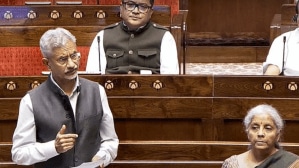Know Your City: How ancient Tamil inscriptions found in and around Bengaluru hark to fluid linguistic borders
The hundreds of stone inscriptions found in and around modern Bengaluru talk about land grants and the building of villages.
 Tamil inscription depicting a wild boar hunt, Devanahalli , circa 1200 C.E Credit Inscriptions 3D Digital Conservation Project. (File photo)
Tamil inscription depicting a wild boar hunt, Devanahalli , circa 1200 C.E Credit Inscriptions 3D Digital Conservation Project. (File photo)The history of modern Bengaluru is said to begin with Kempe Gowda, but the region had been inhabited for centuries before him, with villages and small towns sprawling across the countryside. They are attested by names that survive in neighbourhoods such as Hebbal, and by the hundreds of carved stone inscriptions throughout the region. But something about these inscriptions might surprise most of the residents of Bengaluru — out of around 1,500 stone inscriptions, a third are in Tamil.
According to P L Udaya Kumar of the Inscriptions 3D Digital Conservation Project, which documents the various inscription stones found throughout the city, this hearkens back to a time before the concept of linguistic borders, when the idea of which languages would be spoken in a particular area, was far more fluid.
Udaya Kumar also points out that while a layperson might typically think of the Cholas as a “Tamil” dynasty or the Hoysalas as being associated with Kannada, the ground realities are more complex. “For example, there are more Tamil inscriptions from the Hoysala era compared to the Chola era,” he adds.
Similarly, the use of Kannada would have been common in areas associated with modern Tamil Nadu.
The history of the Tamil inscriptions in the general vicinity of modern Bengaluru goes back to 1007 AD, during the reign of Raja Raja Chola although not personally associated with him at all. In fact, among the 1,500 inscriptions found in the city, only one is directly associated with any ruler — the Tamil inscription by Veera Ballala III, who historians consider as the last great king of the Hoysala Dynasty, at the Chokkanathaswamy Temple in Domlur.
This inscription, however, is similar to the vast majority of those put up by residents near modern Malurpatna — it attributes itself to one Gandan Gandaradittan, possibly a member of the village assembly. It seems to have been set up commemorating a grant of lands to ensure the continuous provision of rice offerings to a certain deity in perpetuity, along with a share to go to the priests.
However, the Tamil and Kannada inscriptions are similar in form and function. Udaya Kumar says, “They do not change just because they use a different language. The nature and the narration are more or less similar.”
The inscriptions in Tamil are found in two different scripts — the “standard” Tamil script of the time and the Grantha script, which would enable the carver to accurately incorporate Kannada and Sanskrit phrases or names in the carving. A few rare carvings bear both Kannada and Tamil scripts.
Among this vast variety of inscriptions, it is hard to talk about their historical value but some are certainly of particular interest from the perspective of Bangalore. Udaya Kumar cites the example of one such inscription in Vibhutipura, which records the building of what was once named Vachchidevarpuram, signed by a superintendent of the area, Ninran, as well as an accountant, Periyapillai. He says, “It is a beautiful inscription which documents the building of a village. It describes the clearing of the forest, the building of houses, a lake, and the naming of the village. Very rarely do you get such explicit records of building a place”.
Often, both Kannada and Tamil might be used in the same area. “The choice of a script is something we cannot yet understand … in the same temple, in the same year, we find both languages used. So why were they used, did they have a preference, was there a reason for using both languages? The choice of language may have been left to the person’s skill at writing a particular language, or the language that the local readers were more conversant in,” says Udaya Kumar.












